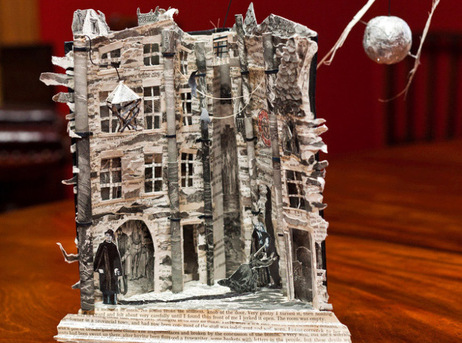


 The Scottish library and museum paper sculptor has returned!
The Scottish library and museum paper sculptor has returned! Monday, October 31, 2011 at 2:09PM
Monday, October 31, 2011 at 2:09PM Judy Giesberg tells the story of the most famous condolence letter ever written in “Lincoln and the Widow Bixby,” the next episode of Humanities on the Road premiering this Friday on PCN-TV.
Giesberg, who is Associate Professor of History at Villanova University, introduces audiences at Laurel Hill Cemetery in Philadelphia to the story of Lydia Bixby, a mother living in Boston who allegedly lost five sons on Civil War battlefields. Moved by the family’s sacrifice for the country, President Lincoln wrote Bixby a condolence letter after hearing of her loss.
Check out PCN-TV website for times and more info at
http://www.humanitiesontheroad.org/home/lincoln-and-the-widow-bixby-premieres-this-friday.html

· We currently have Thirty two active docents, and four docents are on an extended leave of absence.
· They volunteer on average 56 hours in a week. This does not include continuing education sessions—or extra hours spent on independent projects like the room book audit
All of the active Rosenbach docents have successfully completed their evaluations. This included a short written exam, attending at least three continuing education sessions, and finally having their tour followed.
Areas in particular we were paying attention to during the tour evaluations:
Accurate information, enthusiasm and clarity, security and conservation, mentioning other museum efforts such as programs, and the library
This is what we found:
· Our strengths:
Terrific engagement--eye contact and body language, strong story tellers, great love and enthusiasm for the brother’s biography, explaining the economics of the brothers business and financial success, inviting the public to visit the reading room by appointment, our signature programs and HOTs, defining rarity in the library, interactive questioning
· Areas for improvement:
Slowing down, things are beautiful/important, assuming a certain level of knowledge about collections, key cards and lights (about 35% still struggle with these), mentioning exhibitions
· How the education department and Docent Council plan to address these areas:
More continuing education session on touring techniques (Emilie has already led one of these sessions), schedule walk through for all new exhibitions, Docent council efforts: Room books, Library shelf guide
Since the re-configuring of our museum hours we have more overlap in docent shifts and there has been a bit of grumbling about too much down time. I am considering changing the shift schedule to match our busy hours.
· We are currently at capacity with docents and will not run training in the fall.
This report was presented at the staff meeting on April 11, 2011


This morning on Facebook, the British Library posted a clip of Simon Callow reading the “Death of Nancy” scene from Charles Dickens’ masterpiece, Oliver Twist. So brilliantly does Callow (who frequently plays Dickens in one-man shows) perform this scene, that one could easily imagine what it must have been like witnessing Dickens himself perform the very same reading in the last years of his life.
At the time Dickens first contemplated including the “Death of Nancy” scene in his public readings, he was a bit concerned that the subject might be inappropriate for the mixed company ever present at his popular performances. Eager to hear other opinions, he arranged for a preview engagement that took place on November 14, 1868 at St. James Hall, Piccadilly before a special handpicked audience of approximately fifty critics, artists, and literary men of London.
One of those present was (William) Charles Kent (1823-1902), editor, journalist, and friend of Dickens. Before the performance began, Dickens whispered to Kent, "I want you to watch this particularly, for I am very doubtful about it myself!" Kent, who later wrote of the experience, recalled, “In its climax, it was as splendid a piece of tragic acting as had for many years been witnessed.”
There is a delightful connection to this story in the collection at the Rosenbach in the form of a lock of Dickens’ hair that was sent to Charles Kent by Georgina Hogarth, Dickens’ sister-in-law, shortly after the author’s death in June of 1870. One can only imagine what a priceless memento of his literary friend it must have been.
This same lock of hair will be on display in the partner desk for the upcoming Romance at the Rosenbach Tour to be presented in February.

